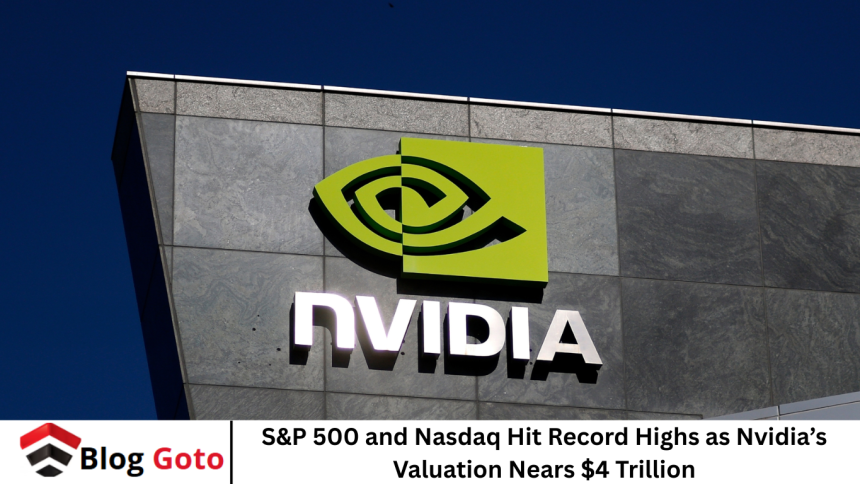On July 10, 2025, U.S. equity markets soared to new heights as both the S&P 500 and Nasdaq Composite surged to record closing levels. Central to this rally was Nvidia (NVDA), which achieved a historic milestone—closing the day with a valuation exceeding $4 trillion, making it the first public company ever to do so.
The U.S. stock market made history this week, with the S&P 500 and Nasdaq Composite both closing at all-time highs—driven largely by an explosive rally in tech stocks, and most notably, a landmark moment for Nvidia. Yet, while celebration is warranted, caution is equally important.
The AI chip giant shattered expectations by becoming the first publicly traded company to close with a valuation surpassing $4 trillion, cementing its place as the undisputed leader in the artificial intelligence revolution. Soaring valuations, trade tensions, and uncertainty around monetary policy still loom large.
More Read: McDonald’s Heats Up Mornings with 3 New Breakfast Items
📈 Market Overview
- Nasdaq Composite closed at 20,630.67, marking its sixth record close in a span of two weeks.
- S&P 500 finished at 6,280.46, crossing previous all-time highs and registering its eighth record close in 2025.
- The Dow Jones rose ~192 points to 44,650, closing within 1% of its historic peak.
Despite concerns around tariffs—including fresh measures on copper and Brazilian imports—investors embraced risk, believing that trade tensions may ease.
💡 Why Nvidia’s Milestone Mattered
On the same day, Nvidia closed at $164.10, marking a valuation of $4.004 trillion.
This milestone reflects:
- A stunning ascent from $1 trillion in roughly two years—driven by surging demand for AI chips in data centers and generative AI applications.
- Its weighting in the S&P 500 now exceeds 7.3%, surpassing even giants like Apple and Microsoft.
- Analysts from Wedbush describe Nvidia as “the foundation for the AI Revolution”.
🌐 Broader Market Context
Beyond tech, other positive signals helped fuel the rally:
- Delta Air Lines forecasted stronger-than-expected earnings, lifting airline stocks significantly.
- Jobless claims fell to a seven-week low, reinforcing the belief in economic resilience.
- Despite lack of consensus around Federal Reserve rate cuts in July or September, markets remain focused on underlying strength—particularly the influence of “mega-cap” AI stocks.
- Bitcoin also set new record highs—surpassing $113,000—a sign of broad risk-on sentiment.
⚠️ Risks & Perspectives
While optimism prevails, some caution remains:
- Valuation Stretch: Nvidia’s $4 trillion tag raises questions of potential overvaluation in tech and AI
- MarketScreener.
- Tariff Uncertainty: Though markets largely shrugged off recent tariffs, escalating trade tensions (like 50% levies on copper and Brazil) could still weigh on key sectors.
- Macro Divergence: Equities remain buoyant even as bond markets signal a slowing economy and inflation risks persist.
Frequently Asked Question
Why did Nvidia’s valuation surge so dramatically?
Nvidia’s GPUs are fundamental to AI infrastructure—supporting generative AI, cloud computing, and supercomputing. Earnings have soared, with revenue up nearly 70% YOY and Q2 guidance around $45 billion .
What impact did Nvidia’s rise have on broader U.S. markets?
Nvidia’s scale and rally boosted both the Nasdaq and S&P 500—the stock alone accounts for over 7% of the S&P 500 index, amplifying tech sector gains.
Are valuations becoming unsustainable?
Analysts warn of “irrational exuberance.” Although AI continues to drive long-term structural growth, current multiples are stretched relative to economic fundamentals .
How did macroeconomic and policy factors play in?
Tariffs on copper and Brazil sparked concerns, but markets largely dismissed them—betting on delayed policy action.
How does Nvidia compare to other mega-caps?
Nvidia’s $4 trillion valuation tops Apple ($3.15 t) and Microsoft ($3.74 t). Often grouped among the “Magnificent Seven,” it’s now the largest of the AI-driven mega-caps.
What are the main risks to watch now?
- Sharp macro pullbacks if Fed signals slower growth.
- Potential trade escalation.
- Sector rotation away from mega-caps or profit-taking in overextended assets.
What’s next for Nvidia and the market?
- Nvidia’s Q3 guidance and AI demand trends are pivotal.
- Tech earnings season ahead could either entrench or correct the rally.
- Watch Fed communications and inflation data; they’ll steer direction after current optimism erupts.
Conclusion
The record-breaking rally of the S&P 500 and Nasdaq, propelled by Nvidia’s historic ascent past the $4 trillion valuation mark, is more than just a milestone—it’s a signal of a fundamental shift in the global economy. As artificial intelligence continues to revolutionize industries, investors are increasingly aligning their portfolios with the companies leading that charge. Nvidia’s dominance illustrates not only the growing demand for AI infrastructure but also the immense market value attributed to innovation and scalability.











